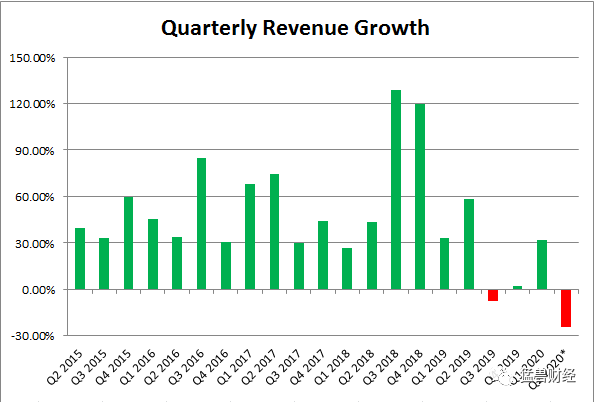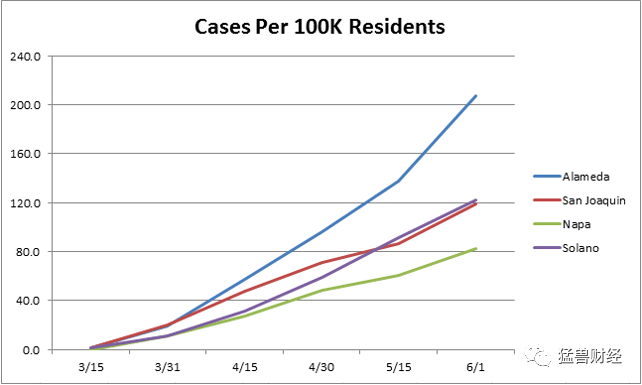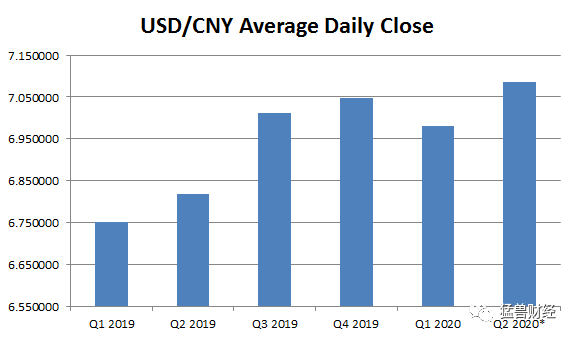If the current situation deteriorates further…
Editor’s note: This article comes from WeChat public account , author: beast Finance.
Tesla expects revenue to fall nearly 25% year-on-year.
Demand is caused by the price reduction, and the delivery time is uncertain.
A stronger dollar is an additional disadvantage.
For Tesla (TSLA), the second quarter results are unlikely to be bullish, which is not surprising. With the outbreak of the new coronavirus causing the Fremont plant to shut down for nearly half a quarter, production will certainly be affected. On the other hand, the global economy shows a sharp decline in GDP, leading to a significant reduction in consumer spending. Although this quarter looks terrible, there are still some things that can make the situation worse in the last month of the quarter.
In the chart below, we want to show how the revenue figures for this period compare to the past five years. As you can see, the second quarter of 2020 will be only the second quarter of this period, the top line will decline, and three of the four weakest growth cycles will be the past 12 months. However, some growth is expected to recover soon, and the current expectation is that revenue growth in the third and fourth quarters of this year will exceed 15% year-on-year, but these figures will still be far below the long-term average.
First of all, we want to start with the second biggest risk to Tesla’s performance in the short term, which is insufficient demand.
At present, the output limit of bull camp has been almost destroyed. On the Tesla Model 3 order page, the delivery time on the US East Coast is estimated to be 2-4 weeks for the standard series plus variants, while the delivery time for the high-end performance version is estimated to be 1-4 weeks. When you think about the time it takes to produce a single car and ship it across the United States, this seems to mean that the demand is quite low. The latest round of price cuts further confirmsThis view.
When we saw Tesla’s latest model, Model Y, the situation became more interesting. The order page of this car shows that the current delivery time is estimated to be only 4-8 weeks, lower than last week’s 8-12 weeks. Considering that Tesla boss Musk has said that Model Y sales will exceed Model S/X/3 combined, the current delivery schedule is not a good sign for sales. Of course, with the passage of time, Tesla is likely to significantly reduce prices and launch more cheaper models, but before the introduction of the mid-range model Model 3, Tesla has been in mass production for about 15 months. In view of the discontinuation of the factory, so far, Model Y may only be produced for about a month or two.
Of course, people who are optimistic about Tesla must also realize that competition and certain tax incentives will also bring another disadvantage. Tesla has had to lower prices in the Chinese market to obtain basic models under subsidized price limits, and the two more expensive models produced in China will not meet the standards a few months after the end of the transition period. At the end of this year, the tax incentives for electric cars in the Netherlands have been downgraded, and one of Norway’s major electric car concessions will also expire. We will also see Volkswagen ID3 being launched in Europe, Polaris 2 entering the global market a few months later, and the Ford Mustang ma-e to be available before the end of this year.
We start with the second largest risk because the biggest risk is related to the Fremont plant itself. If, due to the outbreak of the new corona virus, the factory is forced to close again or significantly reduce operations, Tesla will find itself in a terrible situation. In a previous article about this plant, we discussed Tesla’s article about reopening the plant, which compared Fremont’s Alameda County with some other new cases of pneumonia. As you can see in the updated chart below, the number of cases in Alameda County continues to be much higher than in the other three regions.
As of Monday, the total number of cases in Alameda County is slightly less than 3,500. The population of the region is more than 1.67 million, which means that one out of every 482 people has tested positive so far. Although this does not seem to be much, considering the fact that the Fremont plant has more than 10,000 employees. These simple mathematical calculations can tell us that at least some employees have been or have been infected with the virus, and if not, it will not be too long until someone is infected. Considering that Ford recently had to shut down two factories due to a positive test result, it is not difficult to imagine that Tesla would do the same, especially if another wave of cases hit the region.
Another purely from financeFrom a point of view, the cause of injury is the strength of the dollar.
As of last Friday, the average closing price of the US dollar against the euro this quarter was 1.35% higher than the first-quarter average and 3.55% higher than the British pound. Although Tesla’s sales in Europe will not be as high as in the previous quarters, as the dollar strengthens, Tesla’s revenue in these countries will decrease because the sales prices in these countries have remained unchanged.
However, perhaps the most noteworthy currency at present is the renminbi. In the past few weeks, the US dollar against the yuan has risen to a several-month high, and the average closing price for this quarter will reach the highest level since Tesla began selling Model 3 in China last year. If you combine the strength of the US dollar with the recent price reductions, the price of the basic Model 3 produced in China will fall by approximately US$5,300 when converted by income.
Tesla must also be careful not to incur too many negative reports and damage its brand. Just on Monday, a video of the collapse of the Model 3 autonomous driving system went viral on the Internet. Prior to this, a recent article published by Consumer Reports was extremely negative for the company’s driver assistance functions. In addition, the company announced a new plan that customers must deal with paint problems themselves, probably due to poor quality. Finally, it is disclosed that Tesla’s Buffalo plant is still far below the threshold of its work requirements because the New York State plant has received little investment.
Although Tesla’s second quarter may be the most difficult period in a while, there is still a month left, and the situation is likely to get worse. Decreased order delivery time and lower prices seem to indicate that the current demand is not strong, and if the Fremont plant is affected by a wave of new coronary pneumonia, production may stop again. As the US dollar strengthens in the first quarter, revenue will also be affected more. Despite some troubles, Tesla’s share price has been quite strong this year, but if the current situation deteriorates further, it will be interesting to see how many long positions are held.



